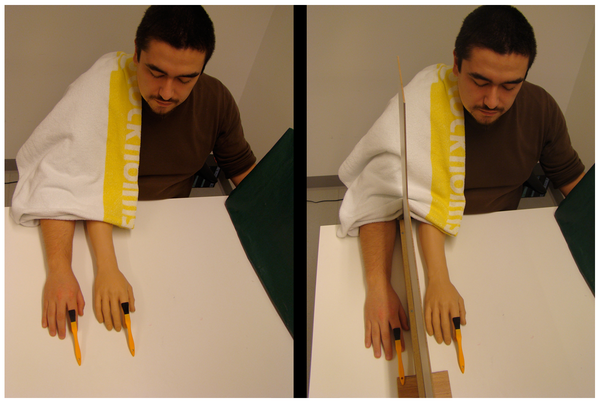In a PLoS ONE aper they describe how it is possible to create an illusion of owning three arms, under controlled conditions in a laboratory. Their experiment involved participants sitting at a table and having a realistic prosthetic arm placed next to their right arm. The subject then sees her two real arms and the extra prosthetic arm, made out of rubber. To produce the feeling of owning the rubber arm, the scientist touches the subject's right hand and the rubber hand with two small brushes at corresponding location – synchronizing the strokes as perfectly as possible.
The study consisted of a series of experiments and 154 healthy volunteers were tested.

Supernumerary hand illusion vs. traditional rubber hand illusion. Set-up used in experiment 5 to elicit the supernumerary hand illusion (left panel) and the traditional rubber hand illusion (right panel). Note that the only difference was the screen occluding vision of the real right hand in the latter condition.
To prove that the prosthetic arm was truly experienced as a third arm, the scientist 'threatened' either the prosthetic hand or the real hand with a kitchen knife, and measuring the degree of sweating of the palm as a physiological response to this provocation. The results demonstrated that the subjects had the same stress response when the prosthetic hand was threatened as when the real hand was, but only during the periods when they experienced the third arm illusion. For instance, there was no stress reaction when the prosthetic right arm was replaced with a left arm or a prosthetic foot.
"What happens then is that a conflict arises in the brain concerning which of the right hands belongs to the participant's body", says Arvid Guterstam, one of the scientists behind the study. "What one could expect is that only one of the hands is experienced as one's own, presumably the real arm. But what we found, surprisingly, is that the brain solves this conflict by accepting both right hands as part of the body image, and the subjects experience having an extra third arm."
"It may be possible in the future to offer a stroke patient, who has become paralyzed on one side of the body, a prosthetic arm that can be used and experienced as his own, while the paralysed arm remains within the patient's body image", says Henrik Ehrsson, who led the study at the Department of Neuroscience. "It is also conceivable that people with demanding work situations could benefit of an extra arm, such as firemen during rescue operations, or paramedics in the field".
Citation: Guterstam A, Petkova VI, Ehrsson HH (2011) The Illusion of Owning a Third Arm. PLoS ONE 6(2): e17208. doi:10.1371/journal.pone.0017208





Comments